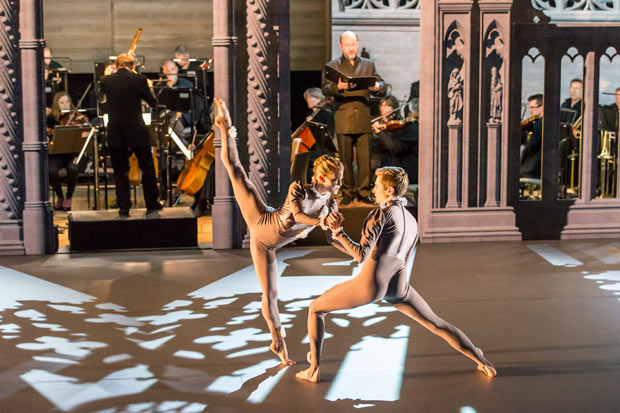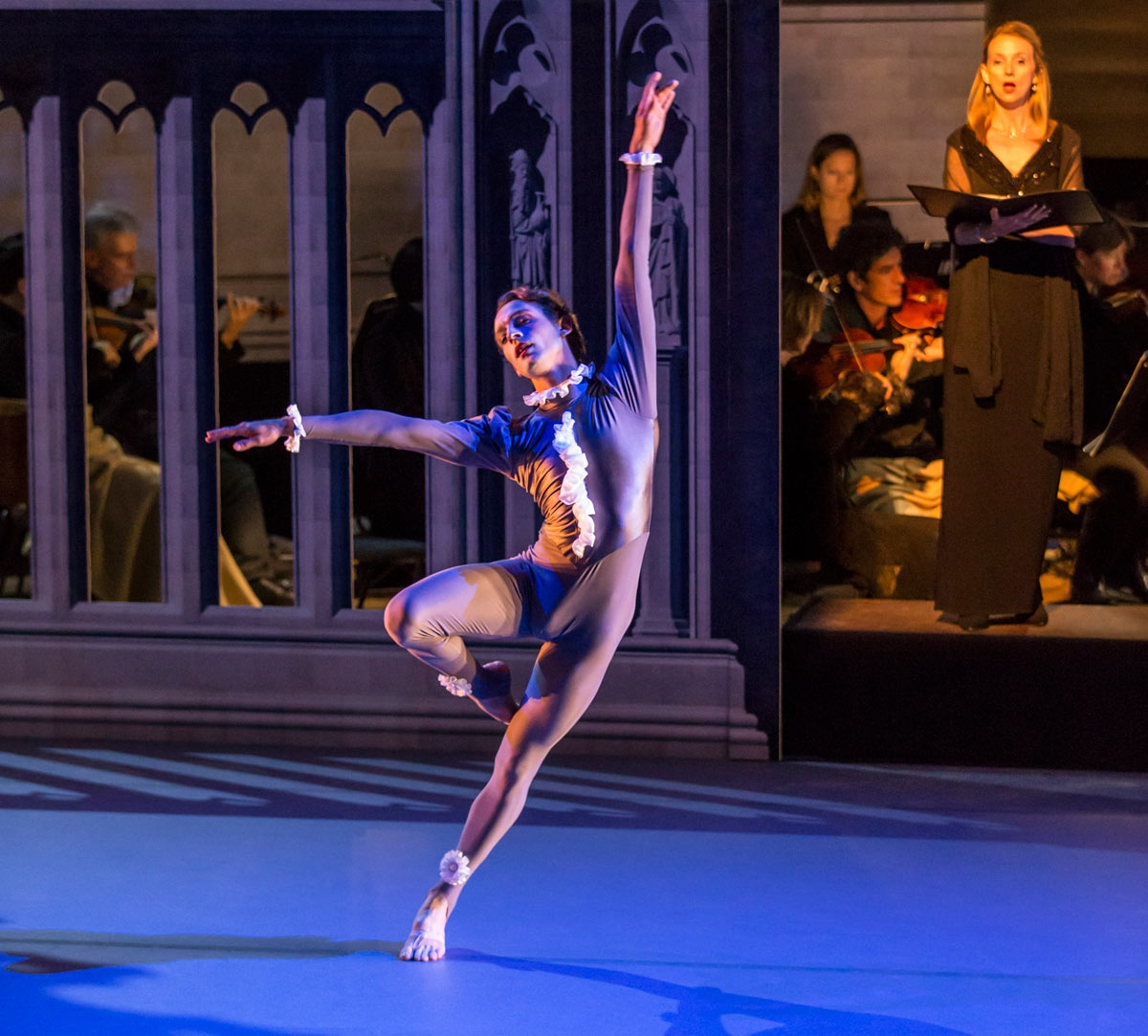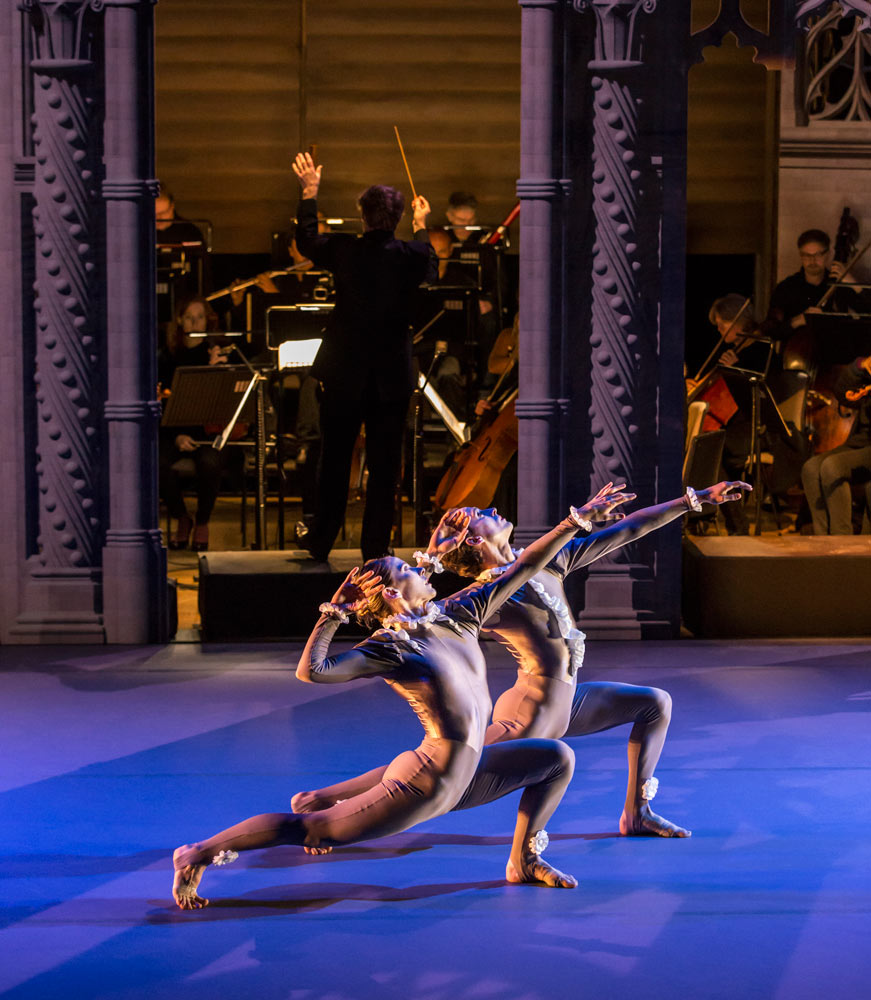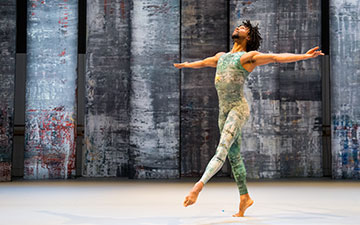
© Johan Persson. (Click image for larger version)
Rambert
The Creation
★★★★✰
London, Sadler’s Wells
11 November 2016
www.rambert.org.uk
www.sadlerswells.com
I was privileged to see the world premiere of Mark Baldwin’s ambitious setting of The Creation at Garsington Opera on a balmy July evening, earlier this year, where the subject of Haydn’s oratorio and the natural environment surrounding that glass opera house in a woodland setting provided the perfect alliance of performance and venue. By contrast, a drizzly November evening in the comparatively dull envelope of Sadler’s Wells seemed destined to be a poor relation.
As it happened, it turned out to be just as joyous an occasion, celebrating the earth’s creation with the great Austrian composer’s 220-year-old masterpiece, beautifully performed and enlivened by adventurous, beguiling choreography on a colossal scale; the Cathedral-cloistered imagery created by Pablo Bronstein’s majestic, gothic façade was accentuated by the evocative suggestions of Jacobean costume – frilled ruffs, cuffs and white flowers- adorning tight unitards for the 40 or so dancers. It seems to be a work that can accommodate a varying number of dancers according to circumstance and stage size.
This is the largest production yet mounted by Rambert – celebrating its 90th Anniversary, this year – accounting for over 110 performers, including 70 musicians and singers. I have distant memories of having once performed in The Creation (as a boy treble rather than a dancer, I hasten to add), more than four decades ago (at the Bedford Corn Exchange, as I recall); and, from that limited performance experience, and listening to many subsequent concerts and recordings, the performance by the Rambert Orchestra and choir of BBC Singers seemed of an outstanding quality.

© Johan Persson. (Click image for larger version)
The text was perhaps not always so clearly articulated, as at Garsington, and it was often difficult to hear sung words with clarity. Nonetheless we were treated to powerful and purposeful expression by the same three soloists as on that July evening: Neal Davies (bass-baritone, representing both Adam and the archangel, Raphael), James Gilchrist (tenor, as the archangel Uriel) and the elegant soprano, Sarah Tynan, as both Gabriel and Eve.
Bronstein is the Argentine artist responsible for the recent Historical Dances in an Antique Setting at Tate Britain and, here, he created another antique setting for Baldwin’s modern riff on historical dance with an extraordinary, imposing white gothic façade, which was the boundary between the musicians behind and the dancers’ space on the front half of the stage. The chorus sat above and behind the orchestra, on raised platforms; and the soloists sang through the archways of the cloisters in Bronstein’s gothic “Abbey”. His architectural sketches of imaginary buildings are often influenced by baroque – the prevailing style a century or so before Haydn’s oratorio – but the style of his architectural section for The Creation appears to date to the early nineteenth century. It serves a useful theatrical purpose while providing the production with a monumental design statement.
Baldwin’s choreography is also monumental in scale. He has succeeded in a huge and adventurous undertaking both in terms of the number of bodies to move in a comparatively small space and representing the scale of the music and its subject. Baldwin’s approach to such enormity is to have tackled the task bit-by-bit, literally one step at a time, creating the work in separate sections, aided by the dramaturge, Peggy Olislaegers, and informed by a creative timeline drawn up in collaboration with Professor Nicola Clayton, a Cambridge academic. This information might suggest the potential for a fractured, episodic framework, literally transcribing Haydn’s structure into movement to match the imagery of the text, but Baldwin’s choreography achieves a holistic flow and generally steers clear of any overtly literal interpretation; although his occasional animal and insect references provide some isolated and welcome moments of humour in amongst the earnestness that respects this most fundamental of all stories.

© Johan Persson. (Click image for larger version)
The different movements and songs within the tripartite structure of Haydn’s oratorio are reflected by the discrete groups of dancers that Baldwin engages in each section. One represents the professional dancers from the Rambert Company, often fragmented into smaller units, from an individual solo to layers of simultaneous duets, moving in different ways to the same music; while the other comprises dancers from the Rambert School. The former wear individual variations on a grey-costumed theme, with white ruffs, cuffs and seams; the latter are dressed uniformly in skin-tight black bodysuits topped by the ubiquitous white ruff. Jacob O’Connell, winner of the contemporary dance section of last year’s BBC Young Dancer competition, who joined Rambert as an apprentice earlier this year, seems often to be a go-between, supplying the links and occupying the gaps between the two ensembles. There must inevitably be a lot of down time for dancers while others are performing but each returning group brings the same high levels of intensity.
The unity and fluidity of the dancers was never compromised and while individual Rambert professionals shone in solos and duets – with especially memorable contributions from Hannah Rudd, Miguel Altunaga, Liam Francis, Daniel Davidson, Pierre Tappon, Vanessa Kang and Joshua Barwick – it was the strength of the whole ensemble, not least in the absorbing sections delivered by the student dancers, which helped make the evening such a resounding and joyous success. Islington may lack the verdant pastures, mature woodland and luscious lakeside of Garsington but the Sadler’s Wells auditorium served to conjure up the magic nonetheless.

















You must be logged in to post a comment.